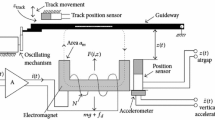Abstract
Magnetic levitation is a method by which an object is suspended with no support other than magnetic fields. The main objective of this study is to demonstrate stabilized closed-loop control of 2-DOF maglev experimentally using real-time control Simulink feature of (SIMLAB) microcontroller. Phase lead compensation and linear quadratic regulator (LQR) controllers are employed to examine the stability performance of the maglev control system under effect of sudden wave signal change and load on maglev plane. The effect of sudden change of applied wave signal on single point, line and plane is presented. Furthermore, in order to study the effect of sudden change of applied load, the direct full load has been applied on all points of the prototype maglev plate simultaneously. Moreover, the airgap distance controlled using phase lead compensation controller is unstable with high oscillation. Meanwhile, LQR controller provided more stability, homogeneous response and good agreement. Additionally, the results of pulse width modulation reveal that the control system using LQR controller provides identical and smooth response to adjust the levitated plane compared to phase lead compensation controller.















Similar content being viewed by others
References
Yaghoubi H (2013) The most important maglev applications. J Eng. https://doi.org/10.1155/2013/537986
An S, Ma Y, Cao Z (2009) Applying simple adaptive control to magnetic levitation system. In: Second international conference on intelligent computation technology and automation, 2009. ICICTA’09. IEEE
Liu H, Zhang X, Chang W (2009) PID control to maglev train system. In: International conference on industrial and information systems, 2009. IIS’09. IEEE
Kumar EV, Jerome J (2013) LQR based optimal tuning of PID controller for trajectory tracking of magnetic levitation system. Procedia Eng 64:254–264
Hypiusová M, Osuský J (2010) PID controller design for magnetic levitation model. In: International conference
Chunfang L, Jian Z (2012) Design of second-order sliding mode controller for electromagnetic levitation grip used in CNC. In: Control and decision conference (CCDC), 2012 24th Chinese. IEEE
Unni AC et al (2016) PID, fuzzy and LQR controllers for magnetic levitation system. In: International conference on cogeneration, small power plants and district energy (ICUE). IEEE
Shawki N, Alam S, Gupta AKS (2014) Design and implementation of a magnetic levitation system using phase lead compensation technique. In: 2014 9th International forum on strategic technology (IFOST). IEEE
Shiao Y-S (2001) Design and implementation of a controller for a magnetic levitation system. Proc Natl Sci Counc 11(2):88–94
Bohn G, Steinmetz G (1984) The electromagnetic levitation and guidance technology of the ‘transrapid’ test facility Emsland. IEEE Trans Magn 20(5):1666–1671
Trumper DL, Olson SM, Subrahmanyan PK (1997) Linearizing control of magnetic suspension systems. IEEE Trans Control Syst Technol 5(4):427–438
Lee S-H et al (2000) Self-tuning control of electromagnetic levitation systems. Control Eng Pract 8(7):749–756
Banerjee S, Prasad D, Pal J (2007) Design, implementation, and testing of a single axis levitation system for the suspension of a platform. ISA Trans 46(2):239–246
Lim TM, Cheng S (2011) Magnetic levitation of a one DOF system using simultaneous actuation and displacement sensing technique. Mechatronics 21(3):548–559
Siddiqui MR, Ahmad S, Asghar U (2017) Stabilizing control of a 1-DOF electromagnetic levitation of pivoted-free rigid ferromagnetic beam. Measurement 106:35–45
Xing F et al (2014) Levitation force control of maglev permanent synchronous planar motor based on multivariable feedback linearization method. In: 2014 17th International conference on electrical machines and systems (ICEMS). IEEE
Passenger Department (2018) Passenger activities at UIC. International Union of Railways (UIC). https://uic.org/IMG/pdf/brochure_passagers.pdf. Accessed Mar 2018
Passenger Department (2018) High speed rail fast track to sustainable mobility. International Union of Railways (UIC). https://uic.org/IMG/pdf/uic_high_speed_2018_ph08_web.pdf. Accessed May 2018
Railway Handbook (2017) Energy consumption and CO2 emissions focus on passenger rail services. International Energy Agency (IEA) and International Union of Railways (UIC). https://uic.org/IMG/pdf/handbook_iea-uic_2017_web3.pdf. Accessed Nov 2017
Caballero-Ruiz A et al (2014) Micropositioning system for the study of neural activity in free-behaving rats. In: 2014 International conference on mechatronics, electronics and automotive engineering (ICMEAE). IEEE
Zou D et al (2008) Maglev system controller design based on the feedback linearization methods. In: International conference on information and automation, 2008. ICIA 2008. IEEE
Zhang F, Suyama K (1995) Nonlinear feedback control of magnetic levitating system by exact linearization approach. In: Proceedings of the 4th IEEE conference on control applications, 1995. IEEE
Biswas P, Bannerjee S (2012) Analysis of UI and UU type rail and actuator used in electromagnetic levitation system using FEM software. Int J Emerg Technol Adv Eng 2(5):32–39
Sailan K, Kuhnert K (2013) DC motor angular position control using PID controller for the purpose of controlling the hydraulic pump. In: International conference on control, engineering and information technology (CEIT’13)
Sintayehu C (2007) Magnetic levitation on a steel ball. Addis Ababa University, Addis Ababa
Author information
Authors and Affiliations
Corresponding author
Additional information
Publisher's Note
Springer Nature remains neutral with regard to jurisdictional claims in published maps and institutional affiliations.
Rights and permissions
About this article
Cite this article
Yaseen, M.H.A. Investigation on planar electromagnetic levitation system using lead compensation and LQR controllers. Electr Eng 102, 725–736 (2020). https://doi.org/10.1007/s00202-019-00905-7
Received:
Accepted:
Published:
Issue Date:
DOI: https://doi.org/10.1007/s00202-019-00905-7




